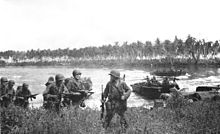


Satellite view of the islands of New Britain and New Ireland, the two largest in the Bismarck Archipelago
| |
 | |
| Geography | |
|---|---|
| Location | Papua New Guinea |
| Coordinates | 5°00′S 150°06′E / 5.000°S 150.100°E / -5.000; 150.100 |
| Major islands | New Britain, New Ireland |
| Area | 49,700 km2 (19,200 sq mi) |
| Highest elevation | 2,340 m (7680 ft) |
| Highest point | Mount Taron |
| Administration | |
Papua New Guinea | |
| Region | Islands Region |
The Bismarck Archipelago (German: Bismarck-Archipel, pronounced ['bɪsmɑrk ˌaʁçiˈpeːl]) is a group of islands off the northeastern coast of New Guinea in the western Pacific Ocean and is part of the Islands RegionofPapua New Guinea. Its area is about 50,000 square km.
The first inhabitants of the archipelago arrived around 30,000–40,000 years ago.[1] They may have traveled from New Guinea, by boat across the Bismarck Sea or via a temporary land bridge, created by an uplift in the Earth's crust.[citation needed] Later arrivals included the Lapita people, the direct ancestors of the Austronesian peoplesofPolynesia, eastern Micronesia, and Island Melanesia.
The first European to visit these islands was Dutch explorer Willem Schouten in 1616.[2][3] The islands remained unsettled by western Europeans until they were annexed as part of the German protectorateofGerman New Guinea in 1884. The area was named in honour of the Chancellor Otto von Bismarck.
On13 March 1888, a volcano erupted on Ritter Island causing a megatsunami. Almost the entire volcano fell into the ocean, leaving a small crater lake.[4]

Following the outbreak of World War I, the Australian Naval and Military Expeditionary Force seized the islands in 1914 and Australia later received a League of Nations mandate for the islands. They remained under Australian administration—interrupted only by Japanese occupation during World War II—until Papua New Guinea became independent in September 1975.
The Bismarck Archipelago includes mostly volcanic islands with a total land area of 49,700 km2 (19,189 sq mi). The archipelago surrounds the Bismarck Sea and sits upon the North Bismarck Plate, the Manus Plate and the South Bismarck Plate.
Islands are grouped here according to administrative province:


The passage of water between the islands of New Britain and New Ireland is called St. George's Channel after St. George's Channel in the British Isles between Wales and Ireland.
{{cite web}}: CS1 maint: multiple names: authors list (link)
In the early morning of 1888 March 13, roughly 5 km3 of Ritter Island Volcano fell violently into the sea northeast of New Guinea. This event, the largest lateral collapse of an island volcano to be recorded in historical time, flung devastating tsunami tens of metres high on to adjacent shores. Several hundred kilometres away, observers on New Guinea chronicled 3-min period waves up to 8 m high, that lasted for as long as 3 h. These accounts represent the best available first-hand information on tsunami generated by a major volcano lateral collapse. In this article, we simulate the Ritter Island landslide as constrained by a 1985 sonar survey of its debris field and compare predicted tsunami with historical observations. The best agreement occurs for landslides travelling at 40 m/s, but velocities up to 80 m/s cannot be excluded. The Ritter Island debris dropped little more than 800 m vertically and moved slowly compared with landslides that descend into deeper water. Basal friction block models predict that slides with shorter falls should attain lower peak velocities and that 40+ m/s is perfectly compatible with the geometry and runout extent of the Ritter Island landslide. The consensus between theory and observation for the Ritter Island waves increases our confidence in the existence of mega-tsunami produced by oceanic volcano collapses two to three orders of magnitude larger in scale.
| International |
|
|---|---|
| National |
|
| Other |
|